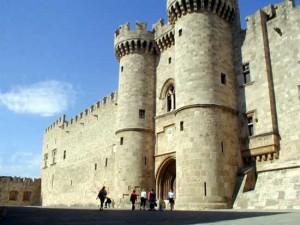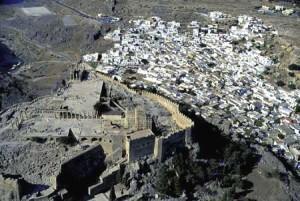Rhodes Island General Intro
Tlepolemus, son of Hercules, a man both brave and large of stature, brought nine ships of lordly warriors from Rhodes. These dwelt in Rhodes which is divided among the three cities of Lindus, Ielysus, and Cameirus, that lies upon the chalk. (Homer's Iliad; Written 800 B.C.E. Translated by Samuel Butler)
 The Island of Rhodes is the sunniest place in Europe; it averages 300 days of sunlight a year. It is the third largest island in Greece. Occupied by Italy until only 56 years ago, it is now “occupied” by thousands of enthralled international visitors.
The “palia poli” (the old city) is the medieval city of Rhodes, surrounded by a high defensive wall (photo right). It is one of the few medieval cities still inhabited in its greater part, excluding its museums, of course. Walking along its cobbled streets, one can almost hear the clapping of iron-armored horses’ hooves and the clang of steel swords clashing. The Italian Palace of the Grand Masters, rebuilt as a weekend resort for Italy’s dictator, Benito Mussolini, is not the most important of its buildings. The Street of the Knights; the Mosque of Suleiman; the Clock Tower; the Turkish Baths, built in 1765 and still in use; the Rhodes Archaeological Museum, built as a hospital by the Knights of St John in 1484; the old Jewish quarter and the square of the Hebrew Martyrs; the Palace of the Admirals, former residence of the Orthodox Archbishop of Rhodes; the Byzantine Museum, including a twelfth century Byzantine church (The Virgin Mary of Victory) in its courtyard; the Decorative Arts Museum; the Ottoman Armory; and the Turkish Library, are only a few among many other interesting sightseeing treasures. Socrates Street, the main shopping street in the old town, is a shopper's paradise, with jewelry, bags, clothes, pottery, embroidery, coats, and just about everything else one can think of.
When you have exhausted your exploration of the Old Town, the New Town of Rhodes, at a short distance from the Old Town, awaits your investigation. It is where the beaches lie, and where hotels, shops, restaurants, discotheques, and even a casino, are packed together to create a lively ambience. It was developed during the 16th century, when Greeks were forbidden, under Turkish rule, to live within the old walled town. Most of the present day buildings date from the Italian occupation.
It has a cosmopolitan air and a splendid choice of boutiques, handcrafts, gold and silver jewelry, and pottery. Strangely enough, for an island so warm and sunny for most of the year, there are also dozens of shops selling fur coats and umbrellas! The area is simply renowned as an exciting international shopper's paradise. It is one of the most highly-developed markets in Greece. T  he variety of goods and services offered is truly inexhaustible and will attract even the most conservative buyer.
A walk in Rodini Park is a must. This park is perhaps the first landscaped park in the world. It is a couple of kilometers away from the Old Town, and one can see part of the ancient aqueduct system of Rhodes within it.
No visit of Rhodes is complete without visiting Lindos (photo left). You'll find Lindos at a distance of 55 km from Rhodes town, on the eastern side of the island. Built in the 12th century B.C., it is now a top-class resort, with a fine sandy beach and a tiny lagoon, which reflects the whitewashed houses and the Lindos Acropolis above them. The village contains many houses dating from the 16th, 17th, and 18th centuries, which are known as the houses of the captains. Their architecture and decoration are unique in the Greek world. Come and admire the sweet scenting Sea daffodils (Pancratium maritimum), peeking out of the hot sand, and blooming under a parching August sun before it even shoots its leaves. |
|



